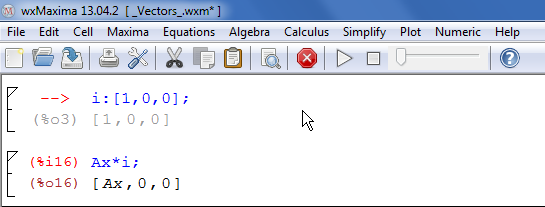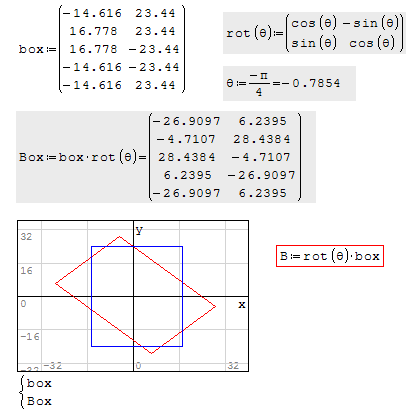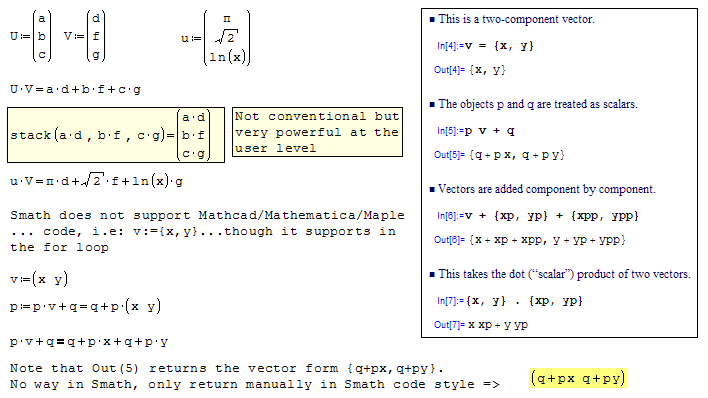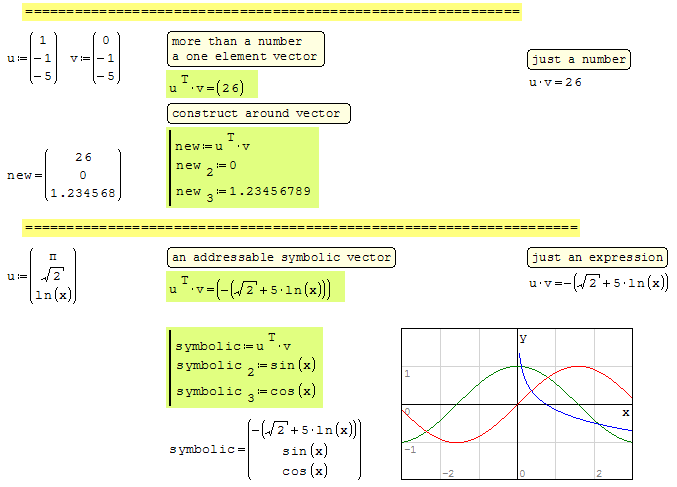[SS-2411] Symbolic evaluation of vectors - Сообщения
Hi Martin, Davide
I am still working about Vectors and what make me wonder is why using symbolic optimization I do not have a correct result for what concern the dot product (Scalar product) of 2 vectors .

There is something that for sure I am missing ..or I am asking too much to Smath ( I was starting to try the same in WxMaxima , if it works with this tool probably using the Maxima plug-in it should work from within Smath too)
Best regards
Franco
I am still working about Vectors and what make me wonder is why using symbolic optimization I do not have a correct result for what concern the dot product (Scalar product) of 2 vectors .

There is something that for sure I am missing ..or I am asking too much to Smath ( I was starting to try the same in WxMaxima , if it works with this tool probably using the Maxima plug-in it should work from within Smath too)
Best regards
Franco
If you like my plugins please consider to support the program buying a license; for personal contributions to me: paypal.me/dcprojects
I also think that it is a bug, has been introduced after 97.5737
Martin KraskaPre-configured portable distribution of SMath Studio: https://en.smath.info/wiki/SMath%20with%20Plugins.ashx
WroteThere is something that for sure I am missing ..or I am askingtoo much to Smath
You are not asking too much to Smath, but you seem not to follow rules
that apply to 1D, 2D, 3D vectors. Those rules are prescribed by convention.
The rules are: Vector * function ... NOT the other way around.
Forum Franco Vector Rules.sm (103,92 КиБ) скачан 650 раз(а).
I am not using/defining any function in my example I am just multiplying in a scalar way same vectors ..or at least I guess so.
Best regards
Franco
Are you reporting that your Smath version does not open my attachment ?
In your example, you mutiply whatever Ax is by a vector. This produces nothing.
Let's assume to make it productive by having A(x):= fnct(x). This would be wrong.
You multiply vector by function [1D,2D,3D vectors] by [1D,2D,3D functions].
That's what the work sheet exemplies by universal maths rules "convention".
Take another example from your book, so more collabs can contribute.
Cheers, Jean
In your example, you mutiply whatever Ax is by a vector. This produces nothing.
Let's assume to make it productive by having A(x):= fnct(x). This would be wrong.
You multiply vector by function [1D,2D,3D vectors] by [1D,2D,3D functions].
That's what the work sheet exemplies by universal maths rules "convention".
Take another example from your book, so more collabs can contribute.
Cheers, Jean
Jean,
I am able to open your example but I simply do not understand the relationship of you example with the issue I am reporting.
As already stated I don't want with my calculations to come up with a number but I would like to see in Smath that the scalar product ( or dot product ) of 2 vectors is the sum of the products of the components on each axis i.e that what should comes up from the symbolic calculations of the product is what is highlighted in yellow herewith :

I don't know if this request is too much for the internal Symbolic engine.
Moreover despite what is shown in the Davide's e-mail I can't evaluate numerically the expression of vector A but I have the expression in red with the error message A.x is not defined ( even because it would be impossible to evaluate it numerically ..I guess or I don't understand clearly the meaning of the "=" operator ).
I am using Smath Studio 0.98 build 6103.
I am pushed to think that Smath does not recognize that the expression of A is the definition of a vector as well the definition of B; so that when I apply the dot vector operator on these structure doesn't happen anything and are not applied the correct simplification rules ( but this is just my modest opinion about what is happening ).
Best regards
Franco
I am able to open your example but I simply do not understand the relationship of you example with the issue I am reporting.
As already stated I don't want with my calculations to come up with a number but I would like to see in Smath that the scalar product ( or dot product ) of 2 vectors is the sum of the products of the components on each axis i.e that what should comes up from the symbolic calculations of the product is what is highlighted in yellow herewith :

I don't know if this request is too much for the internal Symbolic engine.
Moreover despite what is shown in the Davide's e-mail I can't evaluate numerically the expression of vector A but I have the expression in red with the error message A.x is not defined ( even because it would be impossible to evaluate it numerically ..I guess or I don't understand clearly the meaning of the "=" operator ).
I am using Smath Studio 0.98 build 6103.
I am pushed to think that Smath does not recognize that the expression of A is the definition of a vector as well the definition of B; so that when I apply the dot vector operator on these structure doesn't happen anything and are not applied the correct simplification rules ( but this is just my modest opinion about what is happening ).
Best regards
Franco
WroteMoreover despite what is shown in the Davide's e-mail I can't evaluate numerically the expression of vector A but I have the expression in red with the error message A.x is not defined ( even because it would be impossible to evaluate it numerically ..I guess or I don't understand clearly the meaning of the "=" operator ).
"=" is the evaluation symbol (may be numerical or symbolical); type = to request a numerical evaluation, CTRL+. to request a symbolic evaluation (the one in my screenshot), You can even change the requested evaluation by context menu (right click -> optimization)
P.S. I've moved here OT messages from the original topic.
If you like my plugins please consider to support the program buying a license; for personal contributions to me: paypal.me/dcprojects
1 пользователям понравился этот пост
frapuano 05.10.2016 00:51:00
Franco,
No matter what A,B,C will be, from the onset your attempt is wrong.
Why wrong ? You have valued e(x,y,z). So, the next WHATEVER can't
be [A,B,C]*e(x,y,z) but e(x,y,z)*[A,B,C]. That's what the work sheet
previousely attached demonstrates for the 1D, 2D, 3D applications.
I don't understand "projection on axes...". There are 24 ways of
representing a 3D axis sytem. Mathematica and Mathcad don't have
identical system. Smath has no 3D system except the one from
"CreateMesh" or its native 3D plot. The 3 orthogonal directions
result from "monkey business creation".
Jean

![Forum Wrong Vector [Sum dot].gif](/ru-RU/files/Download/yYXGGu/Forum-Wrong-Vector-[Sum-dot].gif)
No matter what A,B,C will be, from the onset your attempt is wrong.
Why wrong ? You have valued e(x,y,z). So, the next WHATEVER can't
be [A,B,C]*e(x,y,z) but e(x,y,z)*[A,B,C]. That's what the work sheet
previousely attached demonstrates for the 1D, 2D, 3D applications.
I don't understand "projection on axes...". There are 24 ways of
representing a 3D axis sytem. Mathematica and Mathcad don't have
identical system. Smath has no 3D system except the one from
"CreateMesh" or its native 3D plot. The 3 orthogonal directions
result from "monkey business creation".
Jean

![Forum Wrong Vector [Sum dot].gif](/ru-RU/files/Download/yYXGGu/Forum-Wrong-Vector-[Sum-dot].gif)
2 пользователям понравился этот пост
I think this is not safe until you assume that every unknown is always a scalar (that might cause several troubles) or there is some way to declare the type of an unknown (scalar/matrix/vector).
About the previous post, by default SMath tries to returns the most compact result; I guess might be matter for the expand() function.
About the previous post, by default SMath tries to returns the most compact result; I guess might be matter for the expand() function.
If you like my plugins please consider to support the program buying a license; for personal contributions to me: paypal.me/dcprojects
Davide,
for what concern your 1st point I guess that instead of declaring a variable a similar result can be accomplished using a different operator .
In WxMaxima I see that the multiplication of a scalar by a vector is done using the "*" while the dot product of vectors is through "." ; in Smath there is just one operator for everything and this probably my be an issue.
Your 2nd point due to my ignorance is not very clear; at least to me the Smath result doesn't look the most compact one when I multiply something that should be a scalar by a vector.
Best regards
Franco
for what concern your 1st point I guess that instead of declaring a variable a similar result can be accomplished using a different operator .
In WxMaxima I see that the multiplication of a scalar by a vector is done using the "*" while the dot product of vectors is through "." ; in Smath there is just one operator for everything and this probably my be an issue.
Your 2nd point due to my ignorance is not very clear; at least to me the Smath result doesn't look the most compact one when I multiply something that should be a scalar by a vector.
Best regards
Franco
Helpful in the "way to please". But from the onset this all Vector stuff is
WRONG, WRONG ....! From the onset you have a vector that could be 1D only,
that could be 2D, that could be 3D. From there apply the the rules:
vector*function. I Have posted a demo sheet for 1D, 2D, 3D
It won't work the other way around "function*vector" because the rules
"vector*function" is the rule, not commutative like 3-2 is not equal to 2-3.
As long as Smath is correct: it can rotate 2D, 3D by the rules rather than
by "user invented rules".
WRONG, WRONG ....! From the onset you have a vector that could be 1D only,
that could be 2D, that could be 3D. From there apply the the rules:
vector*function. I Have posted a demo sheet for 1D, 2D, 3D
It won't work the other way around "function*vector" because the rules
"vector*function" is the rule, not commutative like 3-2 is not equal to 2-3.
As long as Smath is correct: it can rotate 2D, 3D by the rules rather than
by "user invented rules".
Hello NDTMA,
yes your feedback is helpful , I do not use Mathcad but I see that its symbolic evaluation is correct and leads to a vector and the application of the Vectorize tecnique in Smath is a good approach to address my issue ( but to tell the truth I consider this a good tip more than a proper solution ) , need to study and understand it better, I have never used it extensively.
What make me wonder is what Mathcad uses to do the dot product of 2 vectors whose result is a scalar, it has to be something different from "." I guess ( probably a wrong guess)
Thanks a lot
Franco
yes your feedback is helpful , I do not use Mathcad but I see that its symbolic evaluation is correct and leads to a vector and the application of the Vectorize tecnique in Smath is a good approach to address my issue ( but to tell the truth I consider this a good tip more than a proper solution ) , need to study and understand it better, I have never used it extensively.
What make me wonder is what Mathcad uses to do the dot product of 2 vectors whose result is a scalar, it has to be something different from "." I guess ( probably a wrong guess)
Thanks a lot
Franco
- Новые сообщения
- Нет новых сообщений

![2016-10-03 10_22_35-SMath Studio Desktop - [vectors.sm].png](/ru-RU/files/Download/zbVa5E/2016-10-03-10_22_35-SMath-Studio-Desktop---[vectors.sm].png)







